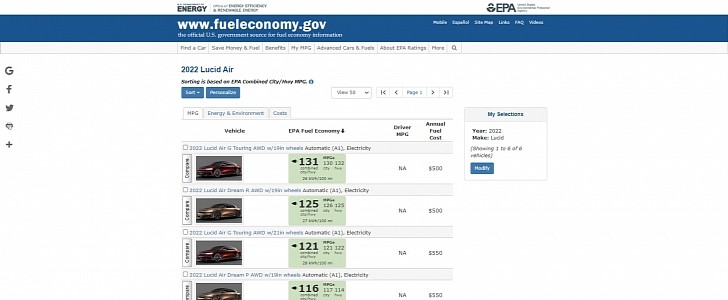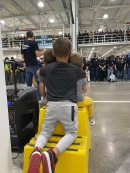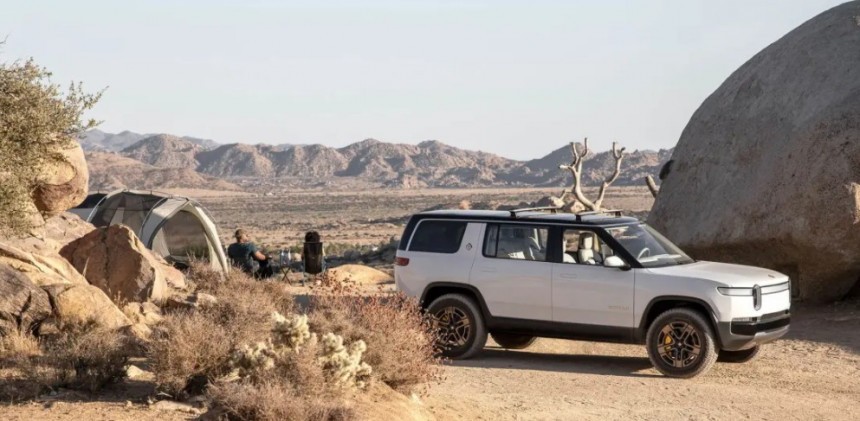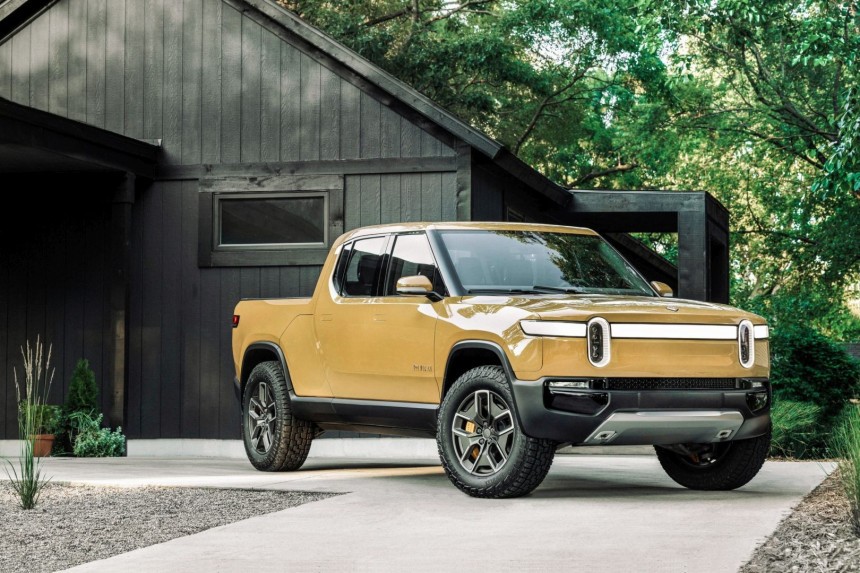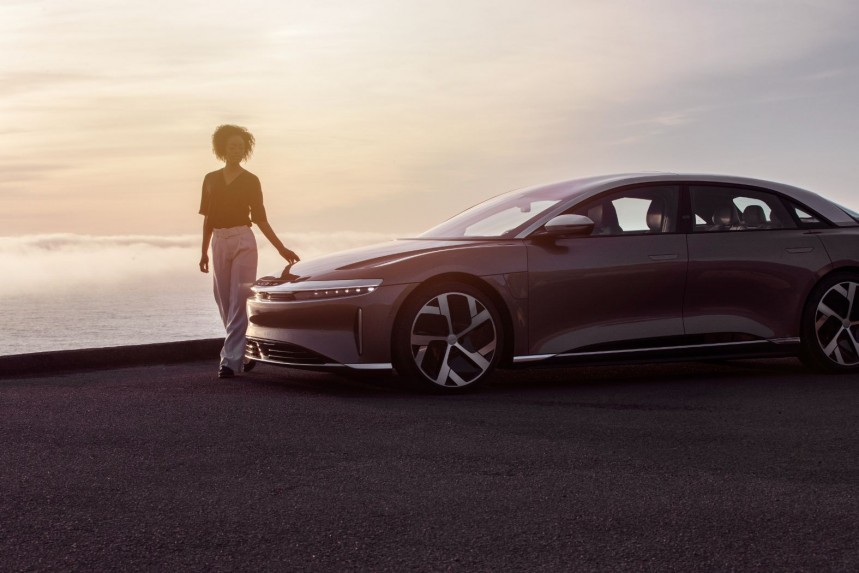Not long ago, Lucid said it expected its first product to have an EPA range of 517 miles (832 km). The awe about the Air was as loud as the teasing that a vehicle that is not for sale is as fictitious as any number it may present. On September 16, Lucid had to recognize it missed its estimates: the official EPA range was higher, at 520 miles (837 km). But there was more to come for those who think there’s room for only one electric car brand in the world.
On September 14, RJ Scaringe announced that the first Rivian R1T for customers was leaving the factory’s production lines in Normal, Illinois. The Rivian CEO also mentioned that the company was ready to deliver the electric pickup truck in all 50 states. Until very recently, people were making bets about who would provide an electric pickup truck faster: Tesla or Rivian. The Cybertruck has been postponed to 2022, but Tesla did not say exactly which month.
These two facts show that Lucid and Rivian are not only about to deliver their first cars. They are also dropping change in a landscape that trusted solely on Tesla for innovation, energy efficiency, or desirable products on electric mobility. And they are only the domestic startup challengers Tesla will face. Chinese brands are around the corner or already defying the Model 3 and the Model Y in some European countries. Even Elon Musk recognized that, although it looked like a PR’s effort to please the Chinese government.
Check NIO, for example. This Chinese company has a better reputation in its home market than Tesla, as does Xpeng. Used car customers prefer EVs from these brands to those the American company produces.
In NIO’s case, that does not have to do exclusively with the higher quality of its cars. NIO also seems to have solved something that bugs people willing to have a daily driver that can also travel long distances. Instead of establishing an exclusive fast charger network, like Tesla, NIO invested in swappable batteries that can be replaced in 3 to 6 minutes. Tesla proposed to do that in the past and quickly gave up on the idea.
In Xpeng’s case, it became the first company ever to launch a vehicle with LiDAR, something Elon Musk called the “fools’ errand.” P5 deliveries should start in October, and the XPILOT 3.5 system may beat Tesla’s FSD by a large margin.
Compared to Tesla, all these companies lack sales and production volumes, but legacy automakers may soon beat the EV maker to that. With all its cars based on MEB and other electric platforms, the Volkswagen Group may quickly sell as many electric vehicles as Tesla currently does. Herbert Diess estimated his company would do so by 2025. Checking the Volkswagen Group’s current numbers, he was probably underpromising to overdeliver.
Rivian and Lucid will take time to get there because they have started their careers with flagships. These EVs will help them to fund their operations with vehicles with beefier profit margins. However, Rivian is already planning two more factories: one in Europe and one in the U.S. Lucid promised Saudi Arabia – one of its largest investors – that it would have a factory in that country. It would complement the ones it already has in Casa Grande, Arizona. The Saudi Arabian plant would export its production to Europe and Asia.
If we get back to innovation, Motor Trend praised Rivian’s suspension system as one of the best it ever tested. Its vehicles are not as energy-efficient as Teslas due to their off-road use, but it is way more efficient than similar vehicles, as we have already shown in a recent article.
When it comes to comparable vehicles, the Lucid Air managed to be much superior to any other EV currently for sale. With a battery pack of 113 kWh and 520 miles of range, it achieves 4.6 miles/kWh. It even seems that EPA made a calculation mistake related to the Lucid Air.
EPA informs it would consume 26 kWh per 100 miles. However, if Lucid’s battery pack really has a 113 kWh capacity and it achieves 520 miles with it, the car actually uses 21.7 kWh/100 miles. That’s way less than the official number EPA informs for the Tesla Model 3 SR+: 24 kWh/100 miles. However, the Tesla’s 50 kWh of usable capacity and its 263-mile EPA range would give it a much lower number: 19 kWh/100 miles, or 5.26 miles/kWh.
The issue is that the Model 3 SR+ would not be able to achieve this official range in real-life conditions. Edmunds made a test with it and got a range of 230 miles (370 km). With it, the Tesla would have the exact 21.7 kWh/100 miles (4.6 miles/kWh) that the Lucid Air presents in its Dream Range derivative on 19-in wheels. It’s messy, I know, but we’ll talk about that in another text.
Motor Trend also tested the Air going from Los Angeles to San Francisco and back at highway speeds. Without any concern with saving energy, the car returned a range of 475 miles (764 km). It would probably go much further than its official EPA range if it were driven only in the urban cycle.
Tesla promised its cars would have a 500-mile range and didn’t deliver that. It said it would achieve full autonomy in 2016 because it was basically a solved problem. Customers that paid for FSD are either still waiting or happily swerving from concrete pillars and pedestrians when the beta software is in control. The Cybertruck’s production would start in 2021. On top of all that, Tesla based all of its future vehicles around the 4680 cells. They are still not ready for production.
That’s more than enough to realize that the company that was pushing for electric mobility a while ago may soon be trailing behind other brands. When that happens, it will probably lose the status of the most valuable car company in the world.
From what we are getting from Lucid, Rivian, NIO, Xpeng, and even Volkswagen, that should not take long if Tesla does not improve its game as fast as possible. Trading its promises for palpable achievements and fixing its current quality control and servicing issues would already help a lot.
These two facts show that Lucid and Rivian are not only about to deliver their first cars. They are also dropping change in a landscape that trusted solely on Tesla for innovation, energy efficiency, or desirable products on electric mobility. And they are only the domestic startup challengers Tesla will face. Chinese brands are around the corner or already defying the Model 3 and the Model Y in some European countries. Even Elon Musk recognized that, although it looked like a PR’s effort to please the Chinese government.
Check NIO, for example. This Chinese company has a better reputation in its home market than Tesla, as does Xpeng. Used car customers prefer EVs from these brands to those the American company produces.
In NIO’s case, that does not have to do exclusively with the higher quality of its cars. NIO also seems to have solved something that bugs people willing to have a daily driver that can also travel long distances. Instead of establishing an exclusive fast charger network, like Tesla, NIO invested in swappable batteries that can be replaced in 3 to 6 minutes. Tesla proposed to do that in the past and quickly gave up on the idea.
Compared to Tesla, all these companies lack sales and production volumes, but legacy automakers may soon beat the EV maker to that. With all its cars based on MEB and other electric platforms, the Volkswagen Group may quickly sell as many electric vehicles as Tesla currently does. Herbert Diess estimated his company would do so by 2025. Checking the Volkswagen Group’s current numbers, he was probably underpromising to overdeliver.
Rivian and Lucid will take time to get there because they have started their careers with flagships. These EVs will help them to fund their operations with vehicles with beefier profit margins. However, Rivian is already planning two more factories: one in Europe and one in the U.S. Lucid promised Saudi Arabia – one of its largest investors – that it would have a factory in that country. It would complement the ones it already has in Casa Grande, Arizona. The Saudi Arabian plant would export its production to Europe and Asia.
If we get back to innovation, Motor Trend praised Rivian’s suspension system as one of the best it ever tested. Its vehicles are not as energy-efficient as Teslas due to their off-road use, but it is way more efficient than similar vehicles, as we have already shown in a recent article.
EPA informs it would consume 26 kWh per 100 miles. However, if Lucid’s battery pack really has a 113 kWh capacity and it achieves 520 miles with it, the car actually uses 21.7 kWh/100 miles. That’s way less than the official number EPA informs for the Tesla Model 3 SR+: 24 kWh/100 miles. However, the Tesla’s 50 kWh of usable capacity and its 263-mile EPA range would give it a much lower number: 19 kWh/100 miles, or 5.26 miles/kWh.
The issue is that the Model 3 SR+ would not be able to achieve this official range in real-life conditions. Edmunds made a test with it and got a range of 230 miles (370 km). With it, the Tesla would have the exact 21.7 kWh/100 miles (4.6 miles/kWh) that the Lucid Air presents in its Dream Range derivative on 19-in wheels. It’s messy, I know, but we’ll talk about that in another text.
Motor Trend also tested the Air going from Los Angeles to San Francisco and back at highway speeds. Without any concern with saving energy, the car returned a range of 475 miles (764 km). It would probably go much further than its official EPA range if it were driven only in the urban cycle.
That’s more than enough to realize that the company that was pushing for electric mobility a while ago may soon be trailing behind other brands. When that happens, it will probably lose the status of the most valuable car company in the world.
From what we are getting from Lucid, Rivian, NIO, Xpeng, and even Volkswagen, that should not take long if Tesla does not improve its game as fast as possible. Trading its promises for palpable achievements and fixing its current quality control and servicing issues would already help a lot.
